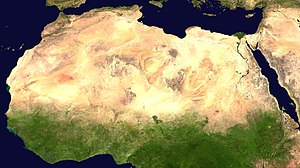Sahara - Simple English Wikipedia, the free encyclopedia

| Part of a series on the |
| Arab world |
|---|
 |

The Sahara,[1] in North Africa, is the largest desert in the world except for Antarctica. The Sahara is the largest hot desert. It is between 4,500 and 5,500 kilometres (2,800 and 3,400 mi) long and between 1,500 and 2,000 kilometres (930 and 1,240 mi) wide.
It is bounded by the Atlantic Ocean, the Atlas Mountains, the Mediterranean Sea, the Red Sea, and the Sahel region. It runs through many countries including Morocco, Algeria, Tunisia, Libya, Egypt, Mauritania, Mali, Niger, Chad, and The Sudan. Most parts are uninhabited, but some people manage to survive in places where there is water.[2]
The Sahara Desert is about 9,200,000 square kilometers (3.6 million square miles) in size. It has been both larger and smaller at different times. After the last ice age it became more fertile, then dried up again. It is the hottest place on the Earth, but not the driest. The driest is the Atacama Desert in South America. The Sahara has about the same size as the whole United States.[3] Since the 1920s, the Sahara had grown by about ten percent, through a process that is known as desertification.[4]
Climate
[change | change source]The Sahara has one of the world's most harsh climates. Typically, the Sahara landscape experiences little rainfall, powerful winds and wide temperature ranges. In some areas, there can be no rainfall for years at a time.
In the summer, daytime air temperatures across the Sahara often reach over 100 degrees Fahrenheit. In the winter the freezing temperatures may occur in the northern Sahara, and milder temperatures, across the southern Sahara. Snow may fall occasionally in some of the higher mountain ranges and rarely, on the desert floor.[5]
Environment
[change | change source]The highest mountain is 3415 m, and is the Emi Koussi in Chad. Some mountain peaks in the Sahara Desert have snow even in the summer.[6][7] The main mountain ranges is the Atlas Mountains in Algeria. The Sahara's lowest point lies in the Qattara Depression in Egypt, at about 130 metres below sea level. Sand sheets and dunes are about 25% of the Sahara. The other parts are mountains, steppes with a lot of stones, and oases.[6]
Several rivers run through the Sahara. However, most of them come and go through the seasons, except for the Nile River and Niger River.[6]
Metallic minerals are very important to most Saharan countries. Algeria and Mauritania have several major deposits of iron ore. There are also uranium mines, mostly in Niger. A lot of phosphates are in Morocco and Western Sahara. Petroleum is mainly found in Algeria, where it is very important to the economy. While mineral exploitation has led to economic growth in Sahara, this has rarely helped the indigenous population, as skilled workers have been brought from other countries.
Cities
[change | change source]Of the Sahara's around 4 million people, most live in Mauritania, Western Sahara, Algeria, Libya and Egypt. Dominant groups of people are Sahrawis and Tuareg people. The largest city is Nouakchott, Mauritania's capital. Other important cities are Tamanrasset in Algeria, and Sebha and Ghat in Libya.
Only 200,000 km² of the Sahara are fertile oases, where dates, corn, and fruits are grown. The few fertile regions today are fed by underground rivers and underground basins. Many of Sahara's oases rests in depressions (areas under sea level) allowing water to surface from underground reservoirs; artesian wells.
The soil in Sahara is low in organic matter. The soil in depressions is often saline.
Other sorts of vegetation include scattered concentrations of grasses, shrubs and trees in the highlands, as well as in the oases and along river beds. Some plants are well adjusted to the climate, allowing them to germinate within 3 days of rain and sow their seeds within 2 weeks after that.
Animals living in the Sahara include gerbil, jerboa, cape hare and desert hedgehog, barbary sheep, oryx, gazelle, deer, wild ass, baboon, hyena, jackal, sand fox, weasel and mongoose. The bird life counts more than 300 species. Reptiles, including 4 species of snake also live here. In the Sahara Desert, you can find the Horned Viper, Sand Viper, Desert Cobra, and Saharan Sand Boa.[8] The most venomous scorpion in the world lives here.
4,000 years ago, the Sahara was a thriving savanna grassland with a great variety of wildlife. This included animals such as elephants and giraffes. Climate change has caused the rainfall to be less and turn the Sahara into the barren, desert wilderness as we know it today.
References
[change | change source]- ↑ Arabic: الصحراء الكبرى, aṣ-ṣaḥrā´ al-kubra, "The Greatest Desert"
- ↑ "Sahara (desert, Africa) -- Britannica Online Encyclopedia". britannica.com. Retrieved 4 May 2010.
- ↑ "The Sahara: Earth's Largest Hot Desert". livescience.com. 2022-02-25. Retrieved 2023-09-21.
- ↑ "New study finds world's largest desert, the Sahara, has grown by 10 percent since 1920". www.nsf.gov. Retrieved 2024-05-05.
- ↑ DesertUSA.com. "The Sahara Desert: Location, Landscape, Water and Climate - DesertUSA". www.desertusa.com. Retrieved 2018-03-04.
- ↑ 6.0 6.1 6.2 "Sahara - LookLex Encyclopaedia". looklex.com. Archived from the original on 16 September 2012. Retrieved 4 May 2010.
- ↑ "Snow in the Sahara". Algeria.com. Retrieved 5 August 2010.
- ↑ curie, Marie (2024-09-13). "Discover the Most Stunning Desert Snakes Worldwide (With Exclusive Pictures)". SNAKES WORLD. Retrieved 2024-09-13.
Other websites
[change | change source]- Flora and fauna of the Sahara Archived 2017-10-08 at the Wayback Machine (in French)
- Also see, the list of All types of Desert Snakes in the World (With Exclusive Pictures)


 French
French Deutsch
Deutsch